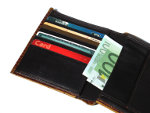How to Clone a Credit Card
Author: John Published Under: Information Security

There are many types of identity theft, but credit card fraud is the most common and most costly type. There are many ways to commit credit card fraud, with the easiest being obtaining a credit card number and using it to make purchases online or over the phone. However, a much more serious and costly type of credit card fraud, called credit card cloning, is becoming increasingly common.
How Credit Cards are Cloned
Once the criminal has obtained a credit card number, there are several options available to manufacture a copy of the credit card. There are three basic ways that a criminal will clone a credit card.
The most costly and most effective method, is to make a realistic copy of the credit card, using the banks colors and holograms. This is fairly easy, although it requires a large upfront investment of around $10,000 for the printing system. In this case, the fake credit card looks just like the original, so will be accepted with little problem. Usually, even though the investment is high, a credit card printing system will quickly pay for itself, because it is possible to create what are, for all intensive purposes, real credit cards.
A much easier and less expensive method is to rewrite the magnetic strip on an expired, stolen, or canceled credit card. This can be done using equipment that costs less than $1000, but poses a number of risks. For one, the credit card number on the card does not match the number on the magnetic strip. As a result, it will not pass a manual review. The other major problem is that a credit card must be obtained, which involves stealing it or committing some other sort of more personal crime, greatly increasing risk. Some criminals, however, will use a hot iron to smooth out the numbers and then re-imprint it, so it looks more authentic.
A third option is to simply use cards, such as a supermarket rewards card, which has a magnetic strip, but does not resemble a credit card at all. This allows the criminal to easily obtain the card, without committing a crime and relatively anonymously. Of course, since a supermarket rewards card looks nothing like a credit card, it will never pass a manual review.
Using a Cloned Credit Card
No matter how much time and effort is taken to make the card, there are a number of risks associated with actually using it, because there could have been a problem during printing, which results in a wrong name, wrong number, or improper magnetic stripe. So, the most risky time is when the credit card is used for the first time.
To help mediate this risk, the criminal will usually find a place where they can use the card without having to actually talk to anyone. This machine based processing is becoming more and more common, with many stores now offering a self-checkout, which allows the criminal to purchase a product without having to let anyone see the credit card. This can also be achieved at most gas stations, which have pay at the pump.
Once the credit card has been verified, the criminal will try to get as much money out of it as possible, until it is detected. Since the victim is using an identical credit card number, this usually happens rather quickly, so the time from the first use to discovery is fairly short. To help avoid detection, the criminal will usually test it using a self-checkout or gas pump regularly, to avoid getting caught using the card fraudulently.